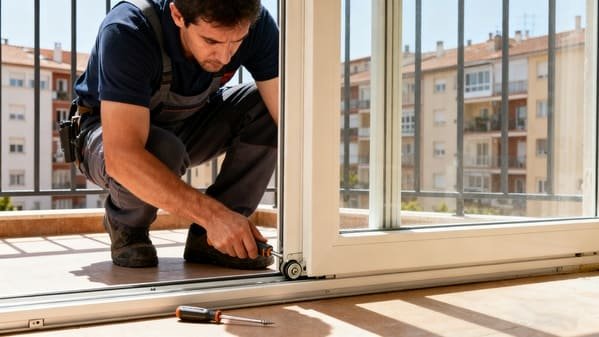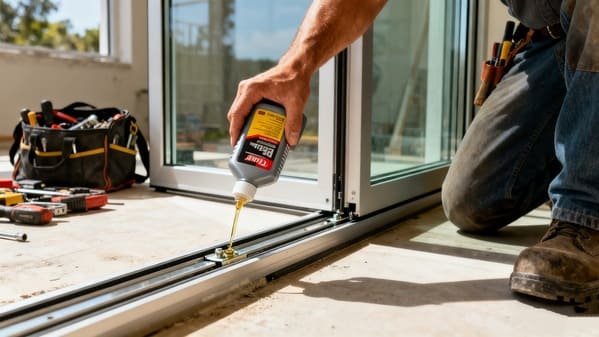Struggling with a sliding door that sticks, scrapes, or squeals? This frustration can wear down components, leading to costly repairs. Simple, regular maintenance is the key to smooth operation.
To maintain sliding door hardware, regularly vacuum and wipe the tracks clean of debris. Then, apply a silicone-based lubricant to the rollers and tracks for smooth operation. Also, periodically inspect and adjust the rollers to ensure the door is properly aligned.

As someone who has spent decades manufacturing these systems, I’ve seen firsthand how a little bit of care can dramatically extend the life of sliding door hardware. It’s not complicated, but knowing exactly what to do and what products to use makes all the difference. Many of my clients, from door factory purchasing managers to construction contractors, ask me for simple tips they can pass on. Let’s dive into the specifics so you can keep your sliding systems working like new for years to come.
What do you lubricate a sliding door track with?
Choosing the wrong lubricant can attract dirt, creating a gritty paste that makes the problem worse. I will show you how to select the right product for a lasting solution.
The best lubricant for a sliding door track is a silicone-based spray. It goes on wet but dries quickly, leaving a slick surface that doesn’t attract dust or grime. This ensures long-lasting, smooth, and quiet operation for both tracks and rollers.

The choice of lubricant is probably the most critical part of sliding door maintenance after cleaning. In my factory, opensliding, we test components with various substances, and the results are always clear. Silicone-based lubricants outperform others for this specific application because they are "dry" lubricants. They don’t leave a greasy, sticky residue. This is essential for door tracks, which are constantly exposed to dust, pet hair, and outdoor debris. An oily lubricant acts like a magnet for this gunk, quickly turning into a thick, abrasive sludge that causes more friction and wears down your rollers. I’ve often seen perfectly good hardware fail simply because it was lubricated with the wrong product. To help you make the best choice, here is a simple breakdown of common options.
| Lubricant Type | Pros | Cons | Best For |
|---|---|---|---|
| Silicone-Based Spray | Dries quickly, repels dust, waterproof | Can make surrounding floors slippery | Tracks, Rollers, Metal Parts |
| Oil-Based Lubricant | Provides heavy-duty lubrication | Attracts dirt, creates grime, can stain | Not recommended for tracks |
| Paraffin Wax | Inexpensive, easy to apply by hand | Wears off quickly, needs reapplication | A quick, temporary fix only |
Should you use WD-40 on sliding doors?
Many people reach for that iconic blue and yellow can to fix anything that squeaks. But using it on your sliding doors might be causing more harm than good in the long run.
You should not use standard WD-40 as a lubricant for sliding doors. It is a water-displacing solvent and cleaner, not a true lubricant. It can clean old grease but evaporates quickly, leaving parts unprotected and attracting more dust.

I get this question a lot, and it’s a common point of confusion. The "WD" in WD-40 stands for Water Displacement. Its primary job is to clean, degrease, and protect metal from moisture. It can make a sticky door feel better for a day or two because it dissolves the old, hardened grease and grime. However, the light mineral oil that provides this temporary lubrication evaporates quickly. What’s left behind is a surface that is clean but unprotected, and it can actually attract dust and dirt more effectively over time. This creates a cycle where you have to reapply it constantly, and eventually, the buildup makes the problem worse. It’s important to note that the WD-40 company does make other products, including a specialist WD-40 Silicone Lubricant. That specific product is excellent for this job. The one to avoid is the classic, multi-use WD-40. A better approach is to use the classic WD-40 for its intended purpose: cleaning. You can spray it on the track, work it in with a rag to break down stubborn gunk, and then wipe the track completely clean and dry before applying a proper, long-lasting silicone-based lubricant.
How to lubricate rollers on a sliding glass door?
You cleaned the track and lubricated it, but the door still feels heavy and makes noise. The problem is likely dirty or dry rollers, which carry all the weight.
To lubricate sliding door rollers, first use a stiff brush and vacuum to clean away all hair and debris. Then, use a silicone spray with a precision straw to apply lubricant directly to the roller axles and wheels to ensure it penetrates.

The rollers are the workhorses of any sliding system. They bear the full weight of the door, so keeping them in top condition is essential for smooth operation. Lubricating them is a simple process, but it requires a bit more care than just spraying the track. You need to make sure the lubricant gets inside the moving parts of the roller assembly. Over the years, I’ve found this step-by-step method to be the most effective.
Step-by-Step Roller Lubrication
- Access and Clean the Rollers: You often don’t need to remove the door. Simply slide it open and look at the bottom. Use a vacuum with a crevice tool to remove all loose dirt. Then, take a stiff nylon brush (an old toothbrush works well) to scrub away any compacted grime, hair, or debris from the wheels and the housing.
- Apply the Lubricant: Use a can of silicone-based lubricant that comes with a thin straw attachment. This allows you to be very precise. Aim the straw directly at the axle in the center of the wheel. Give it a short spray. Also, apply a light coat to the surface of the wheel itself.
- Work it In: After applying the lubricant, slide the door back and forth fully a few times. This movement helps distribute the silicone evenly throughout the bearing and axle mechanism.
- Wipe Excess: Use a clean, dry cloth to wipe away any excess lubricant that may have dripped onto the track or the door. This prevents it from attracting dirt.
How to maintain a sliding door track?
Even with lubricated rollers, a dirty track will cause grinding and sticking. Debris in the track is the number one enemy of a smooth-gliding door and can damage the rollers over time.
Maintain a sliding door track by vacuuming it regularly to remove loose debris. For a deeper clean, wipe it down with a damp cloth and mild soap, using a stiff brush for stubborn grime. Always dry the track completely afterward.

From a manufacturing perspective, the track and rollers are designed as a system. If one part is not maintained, it will cause premature wear on the other. A clean track is the foundation of a healthy sliding door. Debris like dirt, sand, and pet hair gets ground into the rollers, causing flat spots and eventually leading to roller failure. Proper track maintenance is mostly about cleaning. Lubrication is the final step, but it’s ineffective if you apply it over a layer of grime. I advise my B2B clients, especially those in the construction and distribution business, to include a simple maintenance guide for end-users. A regular cleaning schedule is far more important than anything else. Here is a simple checklist you can follow for routine maintenance.
Monthly Track Maintenance Checklist
- Vacuum First: Always start by using a vacuum cleaner with a narrow attachment. This removes all the loose particles so you aren’t just pushing them around with a cloth.
- Wipe Down: Mix a few drops of mild dish soap in a bowl of warm water. Dip a cloth in the soapy water, wring it out, and wipe the entire inside of the track.
- Scrub Tough Spots: For any sticky or stubborn grime, use a stiff nylon brush or an old toothbrush to scrub it away. Avoid using wire brushes, as they can scratch the track’s finish.
- Rinse and Dry: Use a separate cloth dampened with plain water to wipe away any soap residue. Finally, and most importantly, use a dry cloth to wipe the track completely dry. Never apply lubricant to a wet track.
- Inspect for Damage: While the track is clean, run your finger along it to feel for any dents or bends. Minor issues can sometimes be carefully bent back, but significant damage may mean the track needs to be replaced.
Conclusion
Consistent, simple maintenance is the secret to a perfect sliding door. Regular cleaning and using the right silicone lubricant will ensure smooth operation and prevent costly repairs for years to come.

